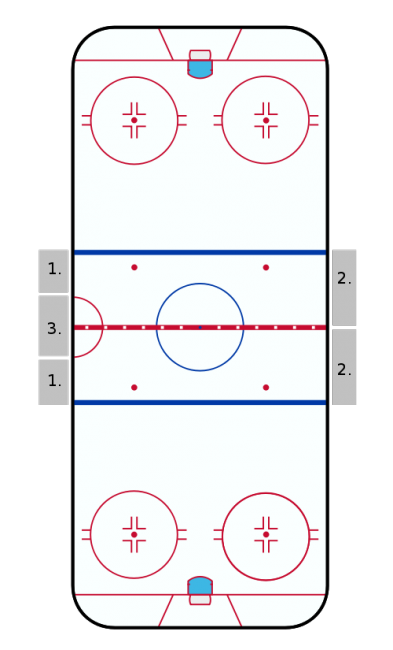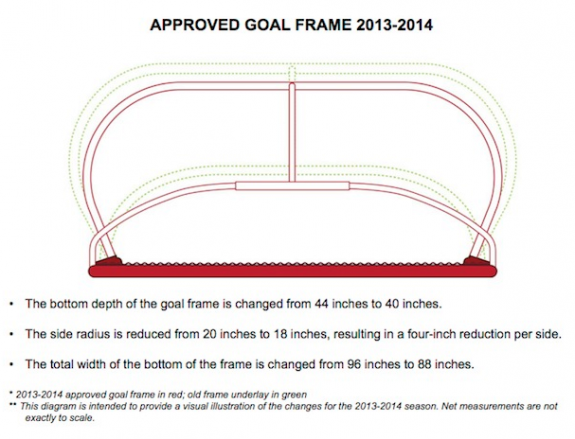The word rink is actually a Scottish word meaning course. The ice hockey rink was originally constructed for the sport of curling. When hockey-specific arenas were built, they retained the name “rink” for the sport. The first ever indoor hockey game was played in 1875 at Victoria Skating Rink in Montreal.
Rink Dimensions
Rinks in North America, including those used in the NHL, are different from those used in the rest of the world. The IIHF (International Ice Hockey Federation) governs hockey in the rest of the world. But we will focus on the NHL specifications.
A rink is around 200 feet (~61m) in length and 85 feet wide (~26m). The rink is rectangular with rounded corners to keep play fast-paced. The edges of these limits are marked by walls rising forty two inches high called boards (acceptable ranges from 40-48 inches). Acrylic glass extends up above the boards to allow for an audience to watch safely behind and also allow the puck to be played off it while keeping the play going. This glass extends vertically eight feet on the ends of the rink and five feet on the sides of the rinks. To protect spectators behind the nets from deflected shots, nets extend around the ends of the rink another 18 feet or so above the glass.
Lines on the Hockey Rink
There are three types of lines that extend across the width of the playing surface. The center red line divides the rink in half (two 100 foot halves). Two thick blue lines cross the rink 25 feet away from the center line. This creates a fifty foot neutral zone in between the two blue lines. The red lines near the ends of the rink are known as the goal line; there is one of these in both ends of the rink. About 64 feet from the blue lines and 11 from the end of the rink, this line also functions as the line the puck must cross for a goal to be scored.
Also: Our Complete Hockey 101 Series
Zones
Four zones divide the playing surface on an ice hockey rink. One of these zones is only applicable to the goalie. To explain the zones we will imagine ourselves to be playing for one team. We will start with the end that our goalie defends. The end of the rink to the first blue line (75 feet) is the defensive zone. Obviously for the fact that we are defending our own goal in it. In between the two blue lines and including the center line (50 feet) is the neutral zone. The remaining 75 feet beyond the second blue line and where the opposing goaltender stands is the offensive zone.
The final zone is a relatively new aspect of the game. Dubbed the Martin Brodeur Rule after the deft puck-handling goaltender, there exists a trapezoid behind the nets in which the goalies are allowed to handle the puck. Diagonal lines extend from the goal line to the boards creating the trapezoid. It is 18 feet wide on the goal line and 28 feet wide along the boards. The remaining sections of ice behind the goal line are restricted areas for goaltenders where they cannot play the puck.
Faceoff Dots
Nine dots denominate where faceoffs take place. There are two in the defensive zone, five in the neutral zone, and two more in the offensive zone. The center ice dot starts play at the beginning of the period and after goals are scored. The defensive and offensive zone dots start play after the puck is frozen or sent out of play while in the zone or in the event of an icing. The four remaining neutral zone dots are used in the event of offsides infraction or if the puck is sent out of play while in the neutral zone.
Circles surround the center ice dot and the four dots in defensive and offensive zones. The only players allowed inside these circles (30 feet in diameter) are the two players participating in the faceoff. Hash marks or the center line denote where the other players can stand.
Goals and Goalie Creases
The above graphic explains the dimensions of the goal mouth and their very recent changes. The goal crease used to exist as a pure half circle with a six foot radius. The NHL plays with a crease that retains the six foot radius but adds in a one foot line from the goal line that extends the crease further out. The goal crease is the section where a goalie is allowed to work unimpeded. Essentially, contact with the goalie while he is in his crease is prohibited.
Benches and Penalty Boxes
Two benches on one side of the rink house the players on each team that are currently not in play. These benches extend the width of the neutral zone and stop at either side of the center line. The boards in front of the benches are intentionally kept without glass in front of them to allow players to change over the top or through the doors to keep the pace quick. Changes on the fly usually have players coming onto the hockey rink over the boards while players leaving the ice go through the doors.
On the other side of the hockey rink, three smaller benches are used for two purposes. The center bench is where the scorekeeper’s table is located. Small benches on either side of this table are the penalty boxes. One for each team, these are used to house a player that has committed an infraction serious enough to warrant a penalty. These three benches have the usual glass in front of them as staff and players do not need to get out of these very quickly.

